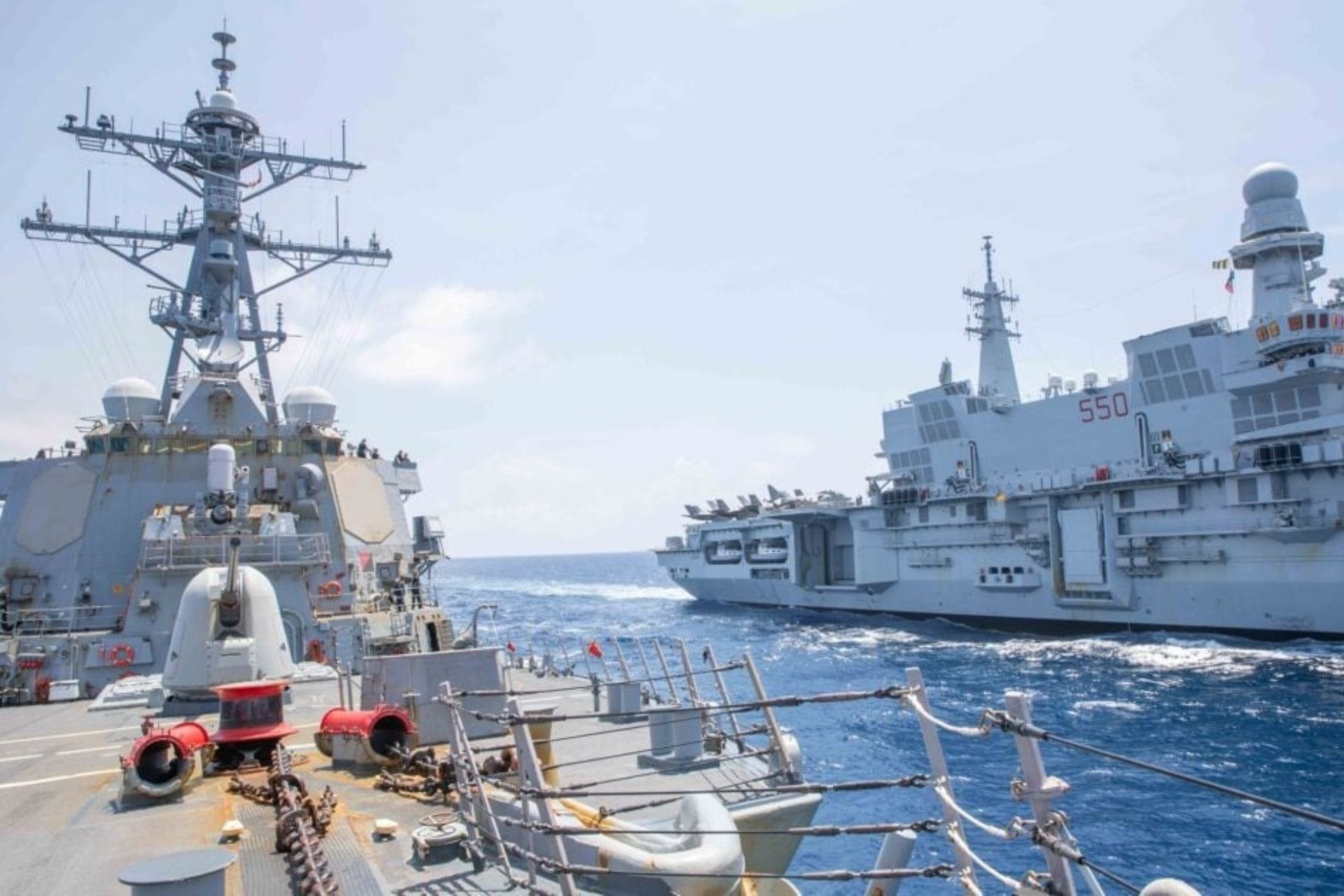Breaking News
Naval Exercises in South China Sea Highlight Growing Cooperation Between U.S., Italy, and Australia.
From September 8 to 11, 2024, the U.S. and Italian navies, alongside the Royal Australian Air Force, conducted joint military exercises in the South China Sea. This four-day operation aimed to strengthen cooperation between the nations and promote a "free and open Indo-Pacific," as outlined in an official statement released on Thursday. These drills took place amidst rising global tensions, with Russian military activity drawing attention due to reported incursions tracked by NORAD and Japanese forces in their respective air defense zones.
Follow Army Recognition on Google News at this link

The Arleigh Burke-class guided-missile destroyer USS Russell (DDG-59) sailed past the Italian Navy’s flagship aircraft carrier ITS Cavour (CV 550) during divisional tactics maneuvering in the South China Sea on September 10, 2024. (Picture source: US Navy)
The naval exercises involved the U.S. Navy's USS Russell (DDG-59), an Arleigh Burke-class guided-missile destroyer, along with the Italian Navy’s Cavour Carrier Strike Group. This group included the aircraft carrier ITS Cavour (CV 550), the frigate ITS Alpino (F594), and the offshore patrol vessel ITS Raimondo Montecuccoli (P432). The Royal Australian Air Force contributed a P-8A Poseidon maritime patrol aircraft to the exercises. These forces collaborated on air defense, anti-submarine warfare, and surface warfare operations, while also enhancing command and control capabilities, tactics, and interoperability.
The USS Russell is an Arleigh Burke-class guided-missile destroyer that has been in service with the U.S. Navy since 1995. Designed for multipurpose missions, it can conduct air defense, anti-submarine warfare, and surface warfare. The destroyer is equipped with the Aegis combat system, enabling it to track and intercept long-range aerial targets. It is also armed with Tomahawk missiles for land strikes and SM-2 missiles for air defense. With advanced radar systems and reinforced hull, the Russell combines offensive and defensive capabilities to operate effectively in high-risk areas.
The ITS Cavour is a light aircraft carrier commissioned by the Italian Navy in 2009. Built by Fincantieri, it is designed to carry short takeoff and vertical landing (STOVL) aircraft, such as the F-35B, as well as helicopters. The Cavour can accommodate 20 to 30 aircraft and also supports amphibious operations through troop landing equipment. Its defensive systems include surface-to-air missiles (Aster 15) and a multi-role radar, providing protection against aerial and naval threats.
The ITS Alpino, a FREMM-class frigate, was commissioned in 2016 and was also built by Fincantieri. It is versatile and suited for anti-submarine, anti-surface, and air defense missions. The frigate is equipped with Aster 15 surface-to-air missiles, Otomat anti-ship missiles, and MU90 torpedoes for submarine warfare. It also carries an NH90 helicopter, enhancing its detection and engagement capabilities. With its modular design, the Alpino is flexible and can be adapted to evolving naval operation needs.
The ITS Raimondo Montecuccoli is an offshore patrol vessel of the Thaon di Revel class, in service with the Italian Navy since 2022. It is designed for maritime surveillance, patrol missions, and humanitarian operations. The Montecuccoli is armed with an OTO Melara 76mm gun and short-range surface-to-air missile systems, allowing it to defend against air and surface threats. It is also equipped with multifunction radar for maritime surveillance and security operations in high-risk areas.
The P-8A Poseidon, a maritime patrol aircraft developed by Boeing, has been in service with the Royal Australian Air Force since 2016. It is primarily used for anti-submarine warfare, maritime surveillance, and search and rescue missions. The Poseidon is equipped with acoustic buoys, Mk 54 torpedoes, and Harpoon missiles for naval warfare. Its advanced radar and sensor systems enable long-range detection of underwater threats, making it a key asset for surveillance missions in the Indo-Pacific region.
Vice Adm. Fred Kacher, commander of the U.S. 7th Fleet, emphasized that these exercises represent significant progress in the ability of the U.S. and its allies to operate together in a complex maritime region. Rear Adm. Giancarlo Ciappina, commander of the Italian Carrier Strike Group, highlighted the professionalism of the crews and their ability to operate cohesively despite being far from their home bases.
The Cavour Carrier Strike Group is nearing the end of its deployment in the Indo-Pacific. Since leaving Manila, Philippines, on September 8, it has been operating in the South China Sea. This cooperation with the U.S. Navy marks the third joint exercise during its current deployment. Prior to this, the Cavour group participated in drills with the Abraham Lincoln Carrier Strike Group in the Philippine Sea in early August.
Meanwhile, the USS Russell, which deployed in February 2024 after three years of inactivity, continues its operations in the Indo-Pacific region and is now part of Destroyer Squadron 15 based in Japan.
At the same time, NORAD tracked two Russian military aircraft operating in the Alaska Air Defense Identification Zone on September 11. These Russian planes remained in international airspace. Additionally, Japan reported that two Russian Tu-142 aircraft operated in its air defense zone on September 12, prompting the deployment of Japanese fighter jets.
In Indonesia, the multinational Super Garuda Shield exercise, involving U.S. and Indonesian forces, demonstrated the U.S. commitment to maintaining peace and stability in the region.
These joint exercises underscore the growing military cooperation between U.S., Italian, Australian, and Indonesian forces.


























